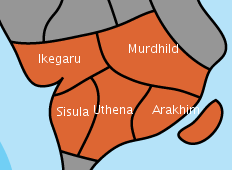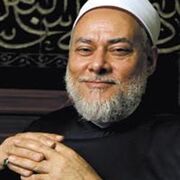| Grand State of Barmenia Brme Hldjogad | |||||
|---|---|---|---|---|---|
| |||||
 none Flag Coat of Arms none Flag Coat of Arms
| |||||
| Anthem "O Barmenia" | |||||

| |||||
| Capital Varishehr | |||||
| Languages Brmek, Kathuran, Selucian | |||||
| Demonym Barmenian | |||||
| Government Selucian constitutional monarchy Queen First Rebeca I Last Queen's Regent First Peter L. Marshall Last | |||||
| Legislature Grand Assembly | |||||
| Area 856,800 km² | |||||
| Population 576,068,791 | |||||
| Currency Barmenistan (BAR) | |||||
The Grand State of Barmenia was the official name of Barmenistan under the Selucian House of Victoria, having overthrown the Vanukean occupation of the nation. The Grand State had a considerable impact on Barmenian culture, as it was under its rule that the Seluco-Barmenians gained political prominence, paving the way for the emergence of Felinism and the eventual establishment of the Feline Homeland of Barmenia.
Politics[]
Head of State[]

Queen's Regent Peter L. Marshall
The Head of State of the Grand State was Queen Rebeca I and her elected Regent. For all practical purposes, the elected Regent was in charge of the executive branch as the Queen herself was too young to rule. The title of Regent was largely symbolic as the elected Head of State was politically independent of the Queen. According to the Barmenian Constitution, the Regent was the only official who can call a new Cabinet.
Head of Government[]

Premier Jacob C. Kennedy
The Head of Government was Premier Jacob C. Kennedy. The Premier governed the Cabinet and represented domestic affairs in the government.
Grand Assembly[]
Supreme Court[]
Officially established in 2592, the Supreme Court interpreted federal law. Five Circuit Courts were established for each state along with State Supreme Courts.
Military[]
The Royal Barmenian Armed Forces consisted of the Army, the Navy, the Air Force, and the Gendarmerie.
The combined troop strength of the Royal Barmenian Armed Forces was 2,004,868
The Monarch's Regent of Barmenia was Commander in Chief of the Royal Armed Forces.
The Military was still referred to as The Royal Barmenistan Armed Forces as a tribute to the history of Barmenia.
Strength
- Army- 2,424,673
- Navy- 997,892
- Air Force- 311,405
- Royal Police- 35,534
Administrative divisions[]
Barmenia was divided into five regions, called States. A region is administered by a Governor and Lt. Governor.
Demographics[]
As of January 2946, the population of Barmenistan stood at a little over 576 million.
Ethnic Groups[]
The largest ethnic group in Barmenistan remained the Brmek people, however they were marginalized and discriminated and most government posts were granted either to Seluco-Barmenians or to sympathetic minorities like Hulstrians or Duntrekkers.
Religious Groups[]

Archbishop Ausonio Padovesi
Selucian Patriarchalism: Although the Selucian Patriarchal Church was still a small minority in both Barmenistan and Terra during the 30th century, Selucian Patriarchals were very powerful in the Barmenian government. The Monarch and her Regent Head of State, the Head of Government, a majority of Cabinet members, and the dominant political parties were Selucian Patriarchal. Their sudden increase in power was largely due to a vacuum in Barmenian politics allowing foreign Selucians to achieve 100% of Grand Assembly seats. The state religion of Barmenistan was Selucian Patriarchalism.
Eastern Rite: The Patriarchal Church (Eastern Rite) remained a small minority in the Grand State, with congregations generally found in Arakhim.
Yeudis: Followers of the Yeudi faith were generally found in the major cities of Ikegaru and Murdhild.
Israi Ahmadism: The dominant religion of Barmenistan was Israi Ahmadism. Over the hundreds of years, Ahmadis in Barmenistan have faced secular atheist democracies, Hosian monarchies, and Ahmadi theocracies, a situation which did not change during the Grand State, when Ahmadis remained second-class citizens.
Grand Mofti
In 2952, the Grand Assembly appointed Ahmadi Cleric Mahmud Falah Safar the Grand Mofti as a concession to the Ahmadi majority. Critics of the move was Safar as a mere puppet for an overly Patriarchal government, while others saw Safar as a peace maker and academic. Safar quickly came under fire by fanatical Ahmadis for resisting calls for Jihad against the Patriarchal Barmenian and Selucian governments in support of Ahmadi Badara

Grand Mufti Mahmud Falah Safar
Religious Census
| Religion | Percentage | |
|---|---|---|
| Israi Ahmadi | 55% | |
| Other Ahmadi | 5% | |
| Selucian Patriarchal | 10% | |
| Luthorans | 4% | |
| Eastern Rite | 2% | |
| Yeudis | 1% | |
| Non-Religious | 20% | |
| Other | 3 |
Languages spoken[]
Despite the heavy explosion of immigration during the radical 25th century that transformed Barmenistan from what was previously a homogeneous society into a consociational state under minority Selucian rule, Brmek remained the official language of Barmenistan, while minority languages were granted government protection. Selucian, while not an official language, had a privileged position as the language of the royal family and the native language of most government members, and many Barmenians adopted Selucian as a second language.
Literacy[]
Education was compulsory until the age of 18. The literacy rate had greatly increased in the previous century to nearly 100 percent of all citizens.
Life expectancy[]
Life expectancy stood at 70.18 years for men and 75.18 years for women, for an overall average of 72.62 years for the populace as a whole.
